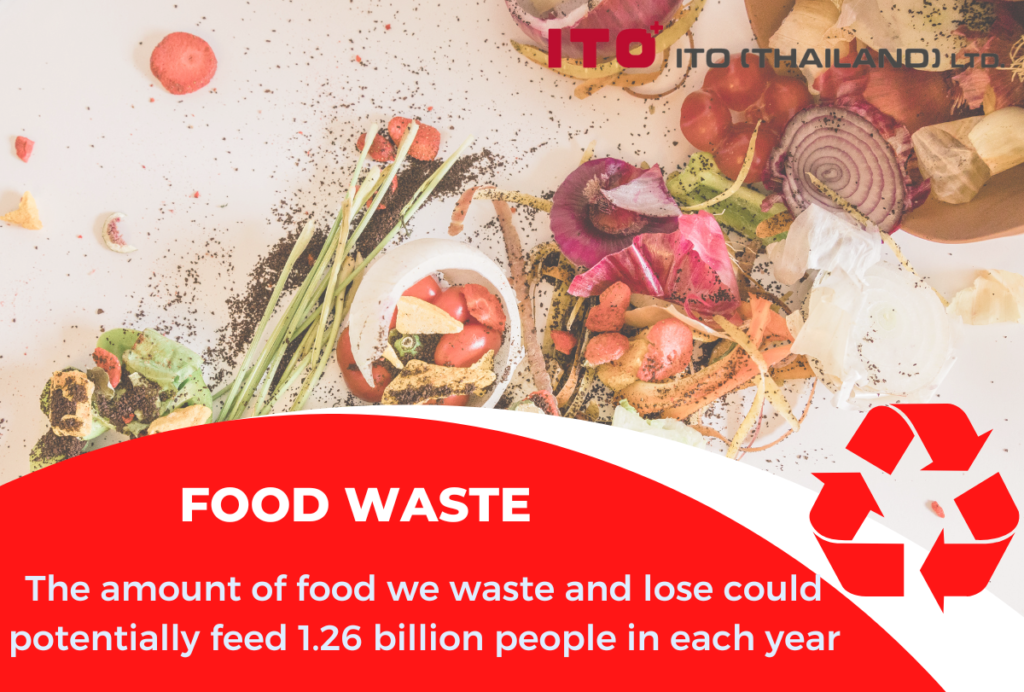ITO Thailand Hygiene Blog
Food Waste
It is reported that the amount of food we waste and lose could potentially feed 1.26 billion people in each year (3), and that is approximately a third of all food we have produced (8), which is contrasting to the sustainable food system we are trying to achieve. Around 14% of food is lost during harvest and retail, while approximately 17% of total global food production is wasted (10). Recently, an awareness of reducing food waste has been risen worldwide, however, food loss reduction is also required. In this blog, we will discuss the definition and differences of food waste and food loss, how they affect climate changes and the environment, and the benefits of less food waste. Moreover, a technology that is being used to lessen food waste, and strategies toward sustainable food management will be discussed as well.
What is Food Waste and Food Loss? And what are their differences?
According to the United Nations Environment Programme, food waste usually occurs at retail, food service, and consumer level (11) at 2%, 5%, and 11% of total global food production, respectively (10). However, food loss is related to any stages prior to retail level (4). We can define food waste as food that has been produced, or prepared, but not consumed by humans, or the inefficient use of food resources, thus negatively impacted the environment (11), and worsen the global food waste situation. For instance, food that is lost, and goes straight to landfill prior to reaching the supermarket’s shelves is considered as ‘food loss’, but if that food has reached consumers and they throw it away even before consumption, can be considered as ‘food waste’ (5).
Effects on Climate Changes and the 17 Sustainable Development Goals
It is important to note that food waste significantly impacts climate changes such as producing 8% of total global greenhouse gas emissions (2), especially when food is rotted, it produces methane, a greenhouse gas which is more severe than carbon dioxide (12). When food is wasted, the energy, and water that were used to grow, transport, and every process in the food system supply chain are wasted as well (12).
On the other hand, the United Nations’ Sustainable Development Goals, Target 12.3 has stated that by 2030, food loss and food waste index will be reduced by 50%, at retail and consumer level for food waste, and during production as well as food supply chain, and post-harvest for food loss (9). Moreover, less food waste also contributes to Target 1 (No poverty), 2 (Zero hunger), and 3 (Good health and well-being) of the 17 Goals, as less food waste will results in a better food system in regard to an ameliorated food security, and food sustainability as well.
The Benefits of Less Food Waste
Less food waste means less impact on the environment, as less methane is generated, so it lessens carbon footprint, and less contribution to global warming (6). Furthermore, less food waste is also related to an improved efficiency in the food supply chain, including food handling, preparation, storage and transport, while the energy and resources that were used will not be wasted (6). Additionally, USDA (U.S. Department of Agriculture) has suggested that productivity and economic efficiency promotion, resources and energy (which are used during food production) conservation encouragement can be achieved with lessening and controlling food waste (1).
Reducing Food Waste Strategies and Technologies
It is possible to reduce food waste in each and every step on the food supply chain, and even on the product itself, for example, with intelligent packaging which allows consumers to monitor and determine which food should be consumed first, as it is able to detect the attributes and optimum condition of food. Moreover, as previously mentioned here (link to AIFST mini magazine) irregular, or misshapen foods, which are perfectly safe to be eaten, are often ‘unnecessary’ packaged to prevent customers from picking the ‘perfect’ fruit.
In regard to the food supply chain, during the production stage, a plant-based edible protective coating (link to plant-based food) is being used to extend shelf-life of fruits and fresh produce (7). Another great example is the introduction of cloud-based inventory management system with AI technology, such as IoT, or computer vision technology to analyse food quality in real-time, so retailers are able to monitor the condition of their products, saleability, level the demand and supply for each products, prevent unnecessary spoilage, and finally, reduce food waste (7). Finally, innovative mobile apps such as Fridgely, FoodKeeper, or Fridge Pal can track foods’ ‘best-before’, or ‘use-by’ dates, provide advice to safely keep the food in an extended period, and in the best condition, as well as a user-friendly interface to make it easier to use (7).
ITO Thailand supports the well-being and good health of consumers, which require a comprehensive understanding of food hygiene and sanitation practice from food handlers. We are proposing hygiene management measures for food factories, as well as consultation services. Click here to learn more.
References
1.Buzby, J. (2022). Food Waste and its Links to Greenhouse Gases and Climate Change. USDA. Retrieved January 19, 2023, from https://www.usda.gov/media/blog/2022/01/24/food-waste-and-its-links-greenhouse-gases-and-climate-change
2.(2022). Tackling Australia’s food waste. Department of Climate Change, Energy, the Environment and Water. Retrieved January 12, 2023, from https://www.dcceew.gov.au/environment/protection/waste/food-waste
3.(2022). Tackling food loss and waste: A triple win opportunity. Food and Agriculture Organization. Retrieved January 9, 2023, from https://www.fao.org/newsroom/detail/FAO-UNEP-agriculture-environment-food-loss-waste-day-2022/en
4.Food and Agriculture Organization of the United Nations, & Nations, F. A. O. U. (2019). The State of Food and Agriculture 2019: Moving forward on food loss and waste reduction. FAO.
5.Generation Vegan. (2022). How Does Food Waste Affect Climate Change in 2022? Retrieved January 19, 2023, from https://genv.org/food-waste-and-climate-change/
6.Harvard T.H. Chan School of Public Health. (2023). Food Waste. Retrieved January 19, 2023, from https://www.hsph.harvard.edu/nutritionsource/sustainability/food-waste/
7.Miller, A. (2021). Solutions for Food Waste: How Emerging Technologies Reduce Waste From Farm to Table. Earth.Org. Retrieved January 19, 2023, from https://earth.org/solutions-for-food-waste-how-emerging-technologies-reduce-waste-from-farm-to-table/
8.Plester, J. (2021). How food waste is huge contributor to climate change. The Guardian. Retrieved January 19, 2023, from https://www.theguardian.com/news/2021/sep/04/how-food-waste-is-huge-contributor-to-climate-change
9.The United Nations. (2016). Ensure sustainable consumption and production patterns. Retrieved January 17, 2023, from https://sdgs.un.org/goals/goal12
10.The United Nations. (2022). International Day of Awareness of Food Loss and Waste Reduction. Retrieved January 12, 2023, from https://www.un.org/en/observances/end-food-waste-day
11.(2021). UNEP Food Waste Index Report 2021. UNEP – UN Environment Programme. Retrieved January 9, 2023, from https://www.unep.org/resources/report/unep-food-waste-index-report-2021
12.World Wildlife Fund. (2023). Fight climate change by preventing food waste. Retrieved January 17, 2023, from https://www.worldwildlife.org/stories/fight-climate-change-by-preventing-food-waste
Related Post
-
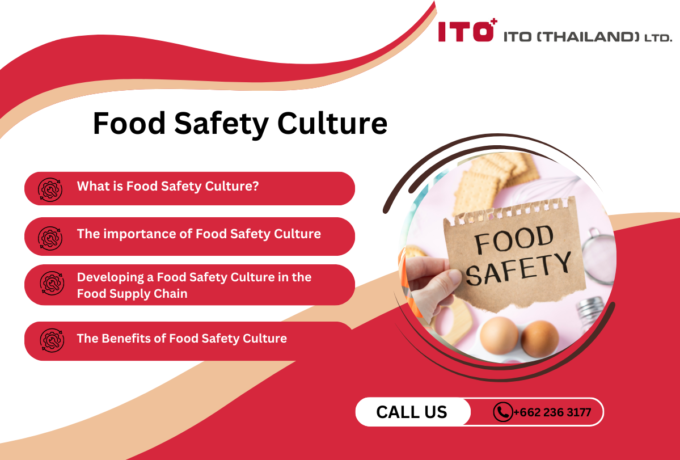
Food Safety Culture
Food safety culture plays a crucial role in safeguarding the company's reputation, ensuring the well-being of its employees, and providing a safe experience for its customers.
-
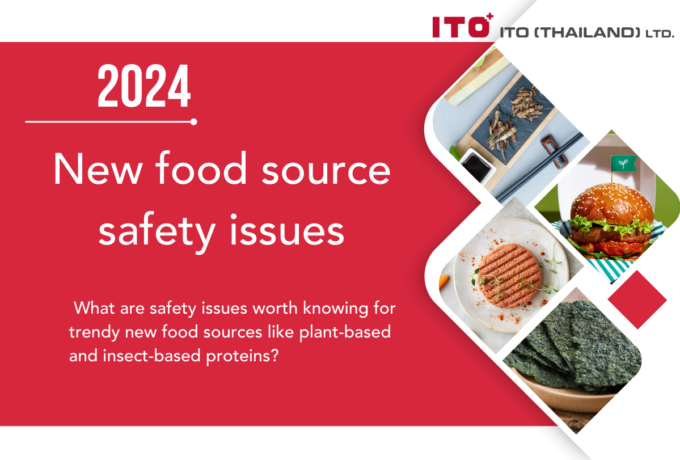
New food source safety issues
What are safety issues worth knowing for trendy new food sources like plant-based and insect-based proteins?
-

British Retail Consortium (BRC) Standard
Food safety management systems play a vital role in ensuring the production and distribution of safe and high-quality food products to consumers. With the global food supply chain becoming increasingly complex, food businesses must implement effective systems prioritising safety, quality, and compliance with industry standards. A food safety management system encompasses a set of procedures, processes, and controls designed to identify, prevent, and manage potential hazards at every stage of the food production and supply process. This proactive approach not only safeguards consumers' health but also protects the reputation and credibility of food companies in an ever more competitive market.
-
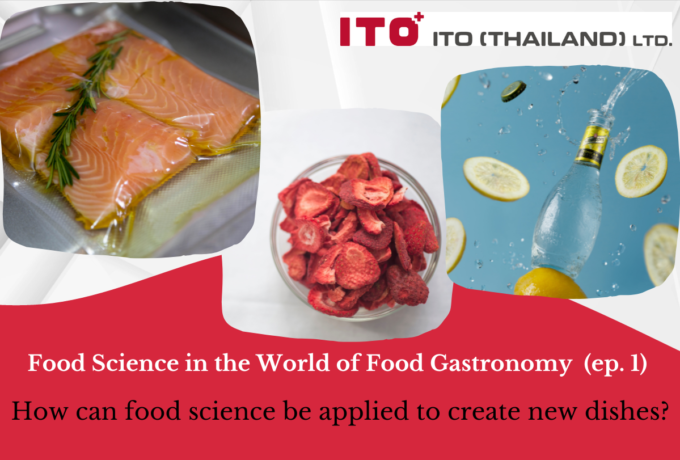
Food Science in the World of Food Gastronomy (Part 1)
How can food science be applied to create new dishes?
-
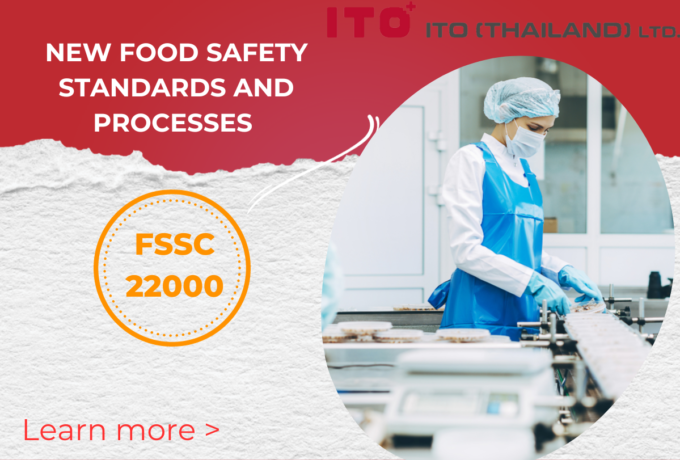
FSSC 22000
Food manufacturers must ensure food safety standards and processes. FSSC 22000 is an official certification program for Food Safety Management Systems (FSMS) recognised by the Global Food Safety Initiative (GFSI). This certification scheme offers a set of guidelines and procedures to ensure uniformity, openness, and safety across your entire supply chain. It applies to all companies operating within the food and beverage industry, ranging from farmers to retailers. By fulfilling the necessary criteria and obtaining FSSC 22000 certification, it is demonstrated that the required standards for food quality and implementing effective processes to manage and mitigate risks associated with food fraud, foodborne illnesses, expensive recalls, and other external threats are met.
-

Food Safety Aspects of Artificial Sweeteners
Artificial sweeteners, also known as sugar substitutes, non-nutritive sweeteners, or high-intensity sweeteners, are artificially produced compounds utilised in place of sucrose (table sugar) to add sweetness to food and drinks. Due to their significantly higher sweetness than regular sugar, only a fraction of artificial sweeteners (200 to 20,000 times less) is required to achieve an equivalent level of sweetness. Since the caloric contribution of these sweeteners, when used in such small quantities, is insignificant, they are often referred to as non-nutritive (4).








